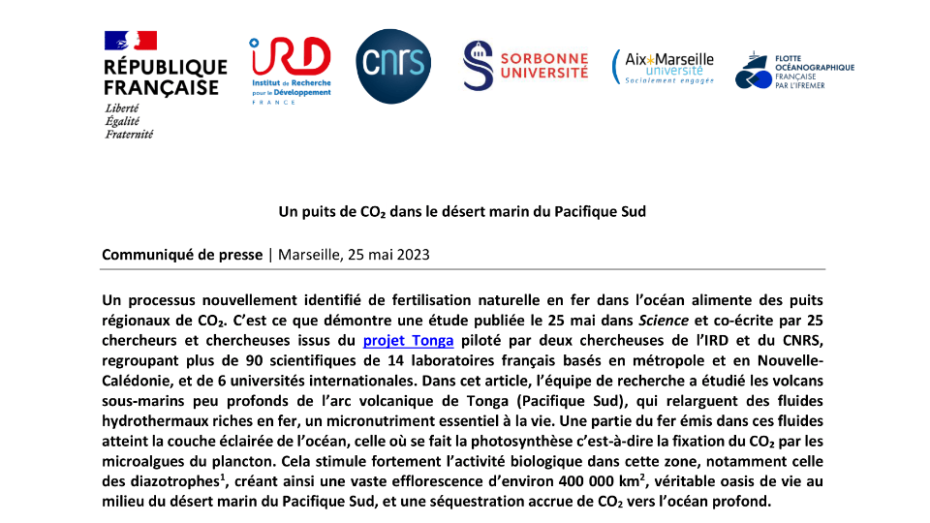
A newly identified process of natural iron fertilization in the ocean fuels regional CO₂ sinks. This was demonstrated by a study published May 25 in Science and co-authored by 25 researchers from the Tonga project. This project was led by two researchers from the IRD and CNRS, with over 90 scientists from 14 French laboratories based in mainland France, New Caledonia, and 6 international universities.
The research team’s article addresses shallow underwater volcanoes in Tonga’s volcanic arc (South Pacific), which release hydrothermal fluids rich in iron, a micronutrient essential for life. Some of the iron emitted in these fluids reaches the sunlit zone of the ocean, where photosynthesis (when plankton microalgae take up CO2) occurs. This stimulates a hot spot of biological activity in the area, particularly for diazotrophs*, leading to large blooms over a surface of 400,000 km2. These blooms are a vast oasis brimming with life in the middle of the South Pacific ocean desert, which increases CO2 sequestration in the “deep” ocean.
The researchers undertook to document the mechanical link between iron released by underwater volcanoes and the response of the plankton community in the surface layer. They combined acoustic, chemical, physical, and biological observations acquired during the 2019 Tonga Oceanographic Expedition onboard the French oceanographic fleet’s vessel L’Atalante, operated by Ifremer.
The results demonstrated that fluids emitted along the Tonga's volcanic arc have a considerable impact on iron concentrations in the sunlit layer. This stimulates biological activity, resulting in the formation of a large chlorophyll-rich living oasis dominated by the diazotroph Trichodesmium. Diazotroph activity there is two to eight times higher than in adjacent areas without iron fertilization, and carbon sequestration fluxes to the deep ocean are doubled or tripled. These results reveal a natural iron fertilization mechanism in the ocean by hydrothermal vents, which fuels regional atmospheric CO2 sinks.
Planktonic diazotrophs are widespread microscopic organisms in the ocean. They play a crucial natural fertilizing role by providing a resource of available nitrogen to the ocean’s surface biosphere, an essential but rare nutrient in most of our oceans. The western subtropical South Pacific is a hotbed of diazotrophic activity. It is estimated that this process contributes 21% of nitrogen generated worldwide through this process.
The supply of iron through atmospheric deposition controls the large-scale biogeographical distribution of diazotrophs, but these aeolian inputs are extremely low in this remote region. This suggests the presence of other iron fertilization processes, such as the one identified above for the first time. Diazotrophs were recently identified as key drivers of future CO2 fixation by the ocean as a response to climate change, and regions where they thrive are expanding with climate change, giving significant importance to the identification of these processes.
*Micro-organisms capable of growth without external sources of fixed nitrogen.
Reference
Sophie Bonnet, Cécile Guieu, Vincent Taillandier, Cédric Boulart, Pascale Bouruet-Aubertot, Frédéric Gazeau, Carla Scalabrin, Matthieu Bressac, Angela N. Knapp, Yannis Cuypers, David González-Santana, Heather J. Forrer, Jean-Michel Grisoni, Olivier Grosso, Jérémie Habasque, Mercedes Jardin-Camps, Nathalie Leblond, Frédéric Le Moigne, Anne Lebourges-Dhaussy, Caroline Lory, Sandra Nunige, Elvira Pulido-Villena, Andrea L. Rizzo, Géraldine Sarthou, Chloé Tilliette.
Institut méditerranéen d'océanologie (CNRS/Aix-Marseille Université/IRD/Université de Toulon), Laboratoire d'océanographie de Villefranche (CNRS/Sorbonne Université), Laboratoire Adaptation et diversité en milieu marin (CNRS/SU), Laboratoire d'océanographie et du climat: expérimentations et approches numériques (CNRS/IRD/MNHN/SU), Geo-ocean Laboratory (CNRS/Ifremer/UBO), Marine Environmental Sciences Laboratory (CNRS/IRD/Ifremer/UBO), Institut de la Mer de Villefranche (CNRS/SU).
Natural iron fertilization by shallow hydrothermal sources fuels diazotroph blooms in the Ocean, Science, May 25, 2023.
Researchers contacts
- Sophie Bonnet, IRD research director, Institut Méditerranéen d’Océanologie ( (M.I.O) - sophie.bonnet[at]mio.osupytheas.fr
- Cécile Guieu, CNRS research director, Laboratoire d'Océanographie de Villefranche - cecile.guieu[at]imev-mer.fr
Press contacts
- IRD: Charlotte Gabet - presse[at]ird.fr - 06 07 36 84 06
- CNRS: presse[at]cnrs.fr - 01 44 96 51 51
- Sorbonne Université: Pauline Ponchaux - pauline.ponchaux[at]sorbonne-universite.fr - 01 44 27 24 53
- Aix-Marseille Université: fanny.trifilieff[at]univ-amu.fr

